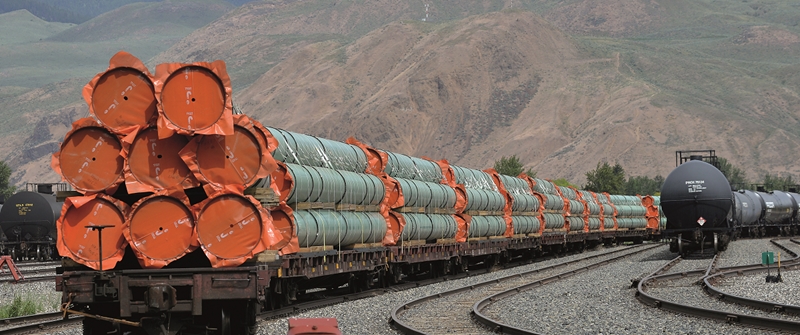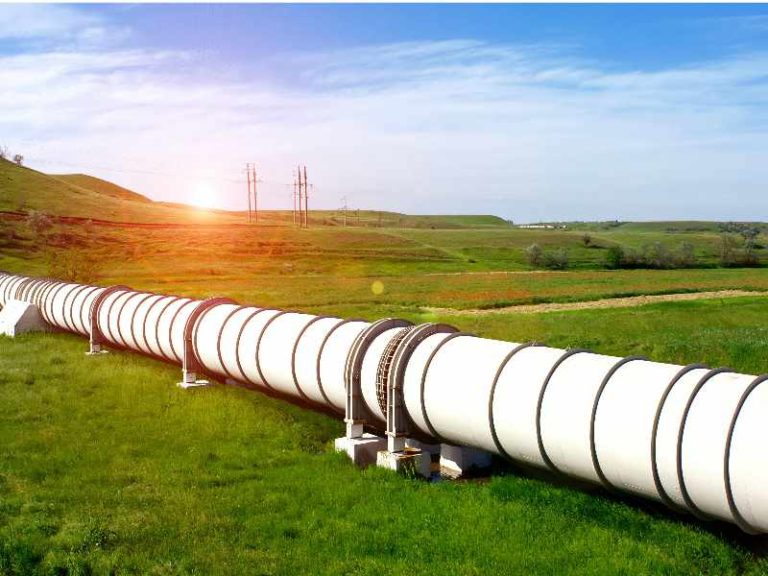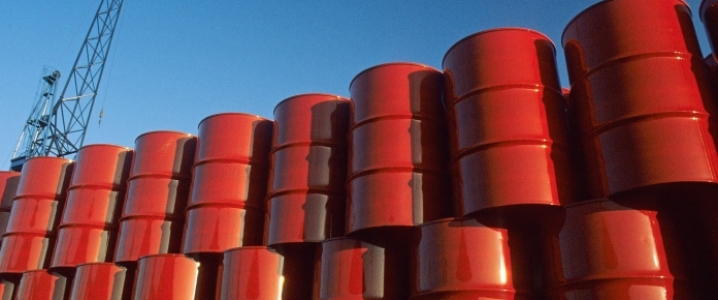By Simon Ferrie
FLNG developments are reaching fresh milestones on the continent, but questions remain about the ability of the smaller players to advance some of these projects without additional partners
FLNG is a relatively new technology, offering shorter development times and lower costs than traditional onshore liquefaction facilities while also not requiring as much supporting infrastructure. So, it is perhaps no surprise that FLNG has found a particular niche in Africa, with its considerable—but largely untapped—gas resources.
Recent months have seen a flurry of FLNG announcements and developments across the continent, led by both international and local firms, but this may be part of an existing trend rather than an upswing in new activity.

Gas pipeline
Italy’s Eni has been a pioneer of FLNG in Africa, with its Coral Sud project in Mozambique dispatching its first cargo in late 2022 and its rapid-deployment, 0.6mt/yr Congo LNG development nearing startup. At the end of December 2023, Eni announced another “key milestone” in its Congolese project, with the first introduction of gas into the Tango FLNG facility.
“Following completion of the commissioning phase, Tango will produce its first LNG cargo by the first quarter of 2024, placing the Republic of Congo on the list of LNG-producing countries,” Eni stated. “A second FLNG facility [with a capacity of 2.4mt/yr] is under construction and will begin production in 2025,” the Italian firm also confirmed, demonstrating its plans to expand its Congolese footprint even further using floating units. And Eni may also be moving towards FID on a second Mozambican FLNG project.
Q1 2024 — Eni’s target for first Congo LNG cargo
In early January, Norway’s Golar LNG announced that the Greater Tortue Ahmeyim (GTA) project’s FLNG unit—known as FLNG Gimi—had arrived at the gas field in preparation for connection. The BP-operated GTA development straddles the maritime border of Senegal and Mauritania, and its first phase will comprise 2.5mt/yr of capacity.
“This is a major step forward for overall delivery of the GTA1 project in Mauritania and Senegal,” said Rahman Rahmanov, BP vice-president of projects for Mauritania and Senegal. Stakeholder Kosmos Energy, a US independent, stated back in November that first gas will be in Q1 2024 but also warned there could be slippage into the second quarter.
And other international firms are already active in the sector. French independent Perenco declared in mid-January that the “Hilli Episeyo, the world’s first FLNG vessel converted from an LNG tanker…has announced the unloading of its 100th cargo of LNG since it began operations in 2018”. Hili Episeyo is moored near Kribi, off the coast of Cameroon, and has a capacity of 2.4mt/yr.
Meanwhile, other developers may also be considering FLNG deployment to Gabon and Angola, although both present additional challenges due to the depth of potential feedgas sources. “We have heard the economics do not stack up for small-/medium-scale FLNG projects in ultra-deep waters,” cautioned Obo Idornigie, vice-president for sub-Saharan African research at consultancy Welligence Energy Analytics. Chinese NOC CNOOC’s Leopard, Seal and Tigre gas discoveries may be potential development sites, but details remain scarce and all three are in ultra-deep waters.
Domestic firms lead way in Nigeria
By contrast, in Nigeria it is local companies that are pursuing FLNG developments, although questions remain over their abilities to finance and complete these projects.
Former NOC NNPC signed a memorandum of understanding with Shanghai-headquartered Wison Heavy Industry at COP28 last December “for the development of floating LNG project in Nigeria”. “Both parties agreed to work together to chart a roadmap for the project development that will lead to an investment decision,” Wison said in a statement, without either party giving further details of the potential scheme. NNPC is also a stakeholder in the country’s flagship onshore NLNG facility, where the addition of a seventh train has encountered significant delays.
And the Nigerian government is keen to promote the development and utilisation of the country’s sizeable gas reserves, as well as hoping for a more general revival in its upstream fortunes. The former NOC may see the rapid-deployment technology as a way to tap those resources in a timely manner, especially with the expected glut of Qatari and US LNG capacity due to hit the market later this decade.
Private-sector Nigerian company UTM Offshore is collaborating with NNPC and the government of Delta State on what they describe as “the development of the first FLNG in Nigeria”. The trio signed a shareholders’ agreement in late December last year for a project in which UTM will hold 72%, Delta State 8% and NNPC the remaining 20%. UTM CEO Julius Rone said that “he expects FID on the project to be taken before the end of the first quarter of 2024”.
Delta State Governor Sheriff Oborevwori said the project has “strategic importance to the national economy” and cites that “40% of Nigeria’s proven gas reserves [are] in Delta State”, making the project “a worthy investment” for the local government. The governor stated that the shareholder agreement was “a significant milestone” and expressed “hope that construction will begin [in 2024]”, although Nigerian politicians have a poor track record for predicting when major infrastructure developments might progress. Senator Ifeanyi Okowa thanked multilateral lender “Afreximbank for helping to arrange the finance”.

Data
“There are question marks around the ability of small independents, with no operating track records, to secure financing” Idornigie, Welligence
Wison is particularly active in Nigeria’s burgeoning FLNG sector, with the Chinese engineering firm also having signed agreements for the “design validation and pre-FEED” works on two FLNG developments, each of 3mt/yr in capacity. The deals are with Nigerian firms Ace Gas & FLNG and Transoceanic Gas & Power; Wison is responsible for designing the FLNG units and for EPC.
Wison plans to “design one and build two” FLNG plants, with one going to Ace at Escravos and Transoceanic’s unit intended for offshore Pennington. In addition to LNG, the units will also produce associated LPG—which is particularly sought after in African domestic markets for cooking and other uses—and supply treated gas to a floating power plant.
Ace Gas CEO Chris Nwokolo noted Abuja’s backing in a statement welcoming the deal, saying “we thank our team, partners and the government for their efforts and support”.
The Ace FLNG project will source gas “from multiple fields” in swamps and shallow waters “close to [the] OML 109 [licence]”, the company explained, predicting a net present value in excess of $1b. The intent to tap shallow-water sources of gas may therefore benefit their Escravos plans, or at least offer fewer challenges than deep waters. “The LNG will be marketed through medium-to-long-term contracts, targeting critical gas shortages in Europe and potentially replacing Russian gas,” the Nigerian firm stated.
“But there are question marks around the ability of small independents, with no operating track records, to secure financing,” warned Idornigie, who noted the expense associated with newbuild FLNG units, which these Nigerian firms appear to be planning to use.
Eni’s Samsung-built Coral Sud FLNG unit cost more than $2b, so “even if these companies are looking at FLNG facility costs of around $1b, they will struggle to secure financing without strong partners”, continued Idornigie. A quicker and cheaper option would be to use a converted FLNG unit instead, but he noted no new orders have been announced by Golar, the firm that has pioneered such conversions.
“The barrier to entry is still high, and I will be surprised if these smaller firms can take FID without bringing in new partners,” continued Idornigie, adding “banks still want to see strong companies with proven track records pushing these projects”. Afreximbank’s apparent involvement in the UTM development may be a positive sign, as is state and NNPC participation, but the scheme itself will still have to satisfy commercial lenders.

“There is definitely appetite for FLNG across the region… [because] there is a lot of stranded gas”, added David Thomson, vice-president for sub-Saharan African research at Welligence. But he too remained cautious, warning that, despite the interest, he does not think there will be “a flood of new developments”, especially from smaller, independent companies.
Thomson emphasised there are “still a lot of hurdles”. Beyond financing, he noted that there are “few companies that have the technical ability”, while the supply of suitable vessels remains tight and the “fiscals do not always work”, suggesting E&P firms may opt to stick with the “quicker payback” still available with oil developments instead.





